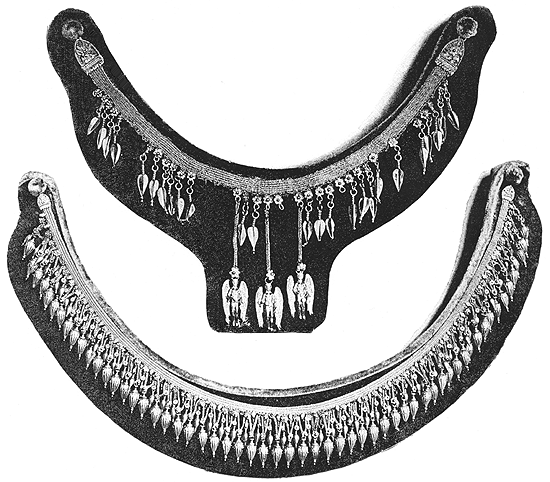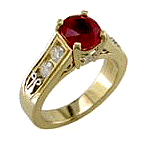
Jewellery as an ArtBy Alice Mullins |
[Editor's Note:During the latter half of the Victorian era, critics questioned the merit of contemporary jewelry and urged a return to the designs and tastes of the past. Like the author of the following article they decried jewelry that had become "mere trinkets and gimcracks at the demand of foolish fashion." Others argued that jewelry could be fun and worthwhile without being pretentious. Not surprisingly, this debate continues today! "A thing of beauty is a joy for ever."
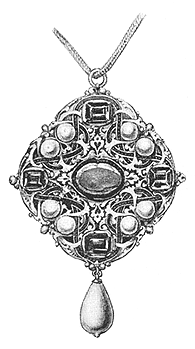
In the present day there is much talk everywhere about art, and signs are not wanting that its vast mission as a humanising and civilising element in our national life is slowly being recognised. Even so-called domestic arts come in for a large share of attention, and the patterns of our wallpapers, and the harmonious colouring of carpets and tapestries, are a matter of thought and care in nearly every household where there is a trifle to spend on luxuries and any pretentions to taste. Yet curiously enough our jewellery, which is the art that lies nearest to us, and follows us wherever we go, and in which there is so much scope for the application of beautiful design and delicate workmanship, is left almost entirely out in the cold; and scarcely any attempt is made to apply to it the same laws, or judge it by the same standards, that we are attempting to set up in other things. All that we ask of our jewellery is that it shall be costly and fashionable; not costly because of the time and loving labour of the artist and workman who designed and produced it, but because of the material alone out of which it is made. It is this Philistine reverence for material that has done more than anything else to debase what was once an art to a mere meaningless and ostentatious display. I know of no more depressing sight to anyone who cares for art than to walk down an important street of shops in one of our big cities, looking in the jewellers' windows on the rubbish, from an artistic point of view, that is there spread out to tempt the public taste. If we could find ourselves by some touch of magic, suddenly under the rule of a stern artistic Socialism, where nothing was permitted to be bought or sold that was not either useful or beautiful, and were a destroying spirit sent one night through the length and breadth of the land, what a blight next morning would have fallen on the jewellers' windows, what few things would be left! But the shop windows are the gauge of the public taste, and it is not the tradesman who sells this costly rubbish, nor the manufacturer who has it made, who are to blame, but ourselves - the public - especially the women not only of to-day, but for the last hundred years or more, who have created the demand for this puerile stuff, and neglected what might be one of the most efficient means of developing the art-instincts of a nation.
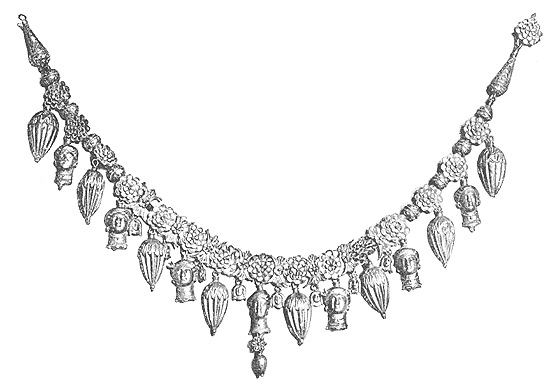
Etruscan Necklace: Pendent Vases and Head of Io Jewellery has been a favourite form of personal decoration from the earliest times. We know with what skill the Etruscans and Greeks worked in precious metals, and that a large part of what is good in our modern jewellery is copied from their designs, and those of other early nations. The Romans, too, wore it freely. The manufacture was extensively encouraged in England in 1685, and it appears as if the fondness for diamonds was greater even then than now, for they were largely used in the ornamentation of rich apparel. We read that King Jame's favourite, the Duke of Buckingham, could afford to have them tacked on so loosely, that, when he chose, he could shake off a gem on the ground, and thus obtain all the fame he desired from the pickers-up, who were generally les dames de la Cour. But in early times the jeweller was a trained artist; and in Italy, where the art especially flourished, many of the great masters developed themselves out of training begun in the goldsmiths' workshops. Francia of Bologna was a goldsmith; indeed, the very name he used was not his own, but that of his beloved master, to whose early training he felt he owed the success of his later years, and he delighted to sign his pictures "Francia the Goldsmith." Botticelli also used the name of the goldsmith with whom he studied. Ghirlandajo was a goldsmith, and the master of Michelangelo, and so was Verrocchio, the part-sculptor of the famous Colleoni statue in Venice, and the master of Leonardo da Vinci. Ghiberti was the stepson of a goldsmith, and to his training in his fathers' workshop he owed the skill that enabled him not only to design, but also to cast the famous gates of the Baptistery at Florence, which Michelangelo said were worthy to be the gates of Paradise. It is not necessary nowadays, under the present system of division of labour, that the jeweller who sells should be a skilled artistic workman, able himself to produce the work to which he stands in the useful though much abused position of the middleman, but it is essential that he should have the taste and training of an artist, to be able, with quick, sympathetic eye, to see what is good and what is bad in the art he fosters, and to choose wisely the labour that shall provide it. When the public have learnt to recognize jewellery as an art this will have to be so.
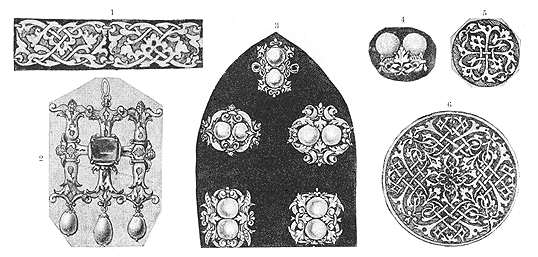
Bracelet (1), Pendant (2) and Brooches (3,4,5,6) after Holbein But it is certain we shall never have artistic jewellery while we think only of the material of which it is composed, and nothing at all of the workmanship, "the meaning given it by a human mind" that is able to turn the raw, uninteresting material into a thing of worth and beauty; and until we learn to see that a bit of bronze or iron, wrought into beautiful and suggestive form by the cunning of man's hand, and the sense of beauty in his heart, is far more worthy to be possessed and worn than any amount of the finest gold stamped out by machinery, or the largest diamonds set to imitate sprays of natural flowers, stars, or butterflies. I do not mean to say that beautiful material wedded to noble design and exquisite workmanship is not to be desired by those who can afford it, but I do say, where limit of price has to be considered, let the material be sacrificed to the workmanship, and let us have silver, bronze, or even iron ornaments with an artist's heart and soul in them, rather than gold and precious stones arranged for mere display because they are in the latest fashion or because they are more costly than our neighbours can afford to wear. I remember being greatly struck by a beautiful little model in wax, executed by Mr. Hamo Thornycroft in the Royal Academy Exibition of 1888, intended to be reduced to half-size and cast in bronze for the clasp of a cloak. In the center of each side was a child's head in profile, in delicate low relief, and round them a severely simple but beautiful design, framing the engraved names of the children and the date. Could any mother desire a lovelier piece of jewellery than this piece of common bronze with the faces of her children moulded in it to wear above her heart when these baby-faces are but a memory of the childhood that so quickly passes away?
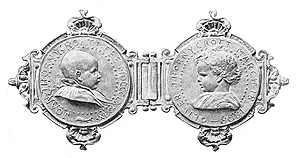 Cloak Clasp by Hamo Thornycroft Another instance of how beautiful jewellery may be produced from comparatively mean material, by good design and skilful workmanship, may be seen in a necklace of modern German work in South Kensington Museum. It is formed of small blackened iron medallions, cast from the antique, and framed in gold, connected by a double row of finely-woven iron links.
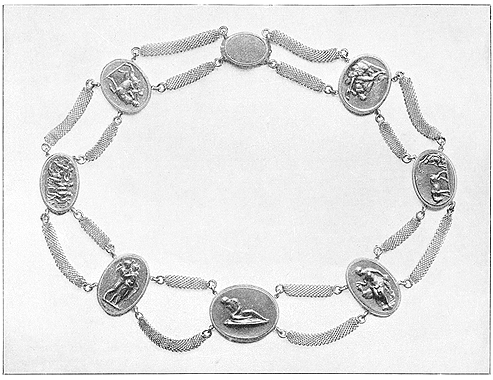
Modern German Iron Necklace In the best period of Greek art, we find that the intrinsic worth of the material used in their jewellery is very slight, and altogether subordinate to the beauty of workmanship and design. The famous Milo necklace in the British Museum is a marvelous specimen of skilled workmanship; and it is in the labour of it, and not in the material, that its great value consists.
* * * * *
Ms. Mullins never had the pleasure of examining a jewel by Bijoux Extraordinaire, but if she had we are sure she would have approved. Here are a few of our
recent creations ....
|
|
|
||
|
| Bijoux Library | Jewelry Galleries | What's New! | | Bijoux Home Page | About Us | Services We Offer | Site Map | If you have any questions, suggestions or comments, please give us a call (603 624-8672) or send us an email.
|
||
|
|
||
